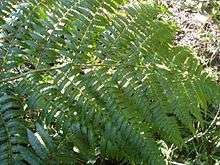Cyathea delgadii
| Cyathea delgadii | |
|---|---|
 | |
| Scientific classification | |
| Kingdom: | Plantae |
| Division: | Pteridophyta |
| Class: | Pteridopsida |
| Order: | Cyatheales |
| Family: | Cyatheaceae |
| Genus: | Cyathea |
| Subgenus: | Cyathea |
| Section: | Cyathea |
| Species: | C. delgadii |
| Binomial name | |
| Cyathea delgadii Pohl ex Sternberg, 1820 (republ. 1829) | |
| Synonyms | |
| |
Cyathea delgadii is a widespread species of tree fern native to Costa Rica, Panama, Venezuela, French Guiana, Guyana, Trinidad, Colombia, Ecuador, Peru, Bolivia, Argentina, Paraguay, and Brazil.
The specific epithet delgadii refers to Gancho do Generale Delgado, along the road to Caldas Novas, Brazil, where the type material was collected.
Distribution
Cyathea delgadii grows in tropical and submontane rain forest, forest understory, in open locations, and along paths, at an elevation of 100 metres (330 ft) and above (up to 2,700 metres (8,900 ft) in Peru). It forms part of a large complex centered on Cyathea fulva.
In Costa Rica, C. delgadii is present in the Cordillera de Guanacaste, Cordillera de Tilarán, north slope of the Cordillera Central, the Norte region, Caribbean side of the Cordillera de Talamanca, Fila Costeña, and the Osa Peninsula, where it has an altitudinal distribution of 500-1500 m (Alexander Rojas A., 1999).
Since it is abundant where it does grow and has such a large natural range, the conservation status of C. delgadii can be equated with the IUCN category "Lower risk" (Alexander Rojas A., 1999).
Description
The trunk of Cyathea delgadii is erect, 1.5–10 metres (4.9–32.8 ft) tall and 5-15 cm in diameter. Fronds are bipinnate and 1.5–3 metres (4.9–9.8 ft) in length. The crown is large and slightly arching.
Petioles are yellow-brown to dark brown in colouration and bear spines. Small brown scales cover the rachis, which is also brown. Sori are borne on each side of the pinnule midvein and are protected by globose indusia.
Cultivation
Cyathea delgadii is cultivated as an ornamental tree for gardens. To do well in cultivation, plants should be provided with consistent moisture and well-drained humus as a substrate. This species does best when sheltered from the wind and grown in a warm area.
The roots of this species are used for the culture of orchids and the manufacture of crafts. C. delgadii may grow on disturbed land and, since it is often harvested from these areas, its use does not have as great an impact on the forest as it would otherwise.
References
- Braggins, John E. & Large, Mark F. 2004. Tree Ferns. Timber Press, Inc., p. 123. ISBN 0-88192-630-2
- The International Plant Names Index: Cyathea delgadii
- Alexander Rojas A. 1999. Especies de Costa Rica: Cyathea delgadii